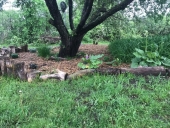



Esbjorn Aneer wrote:Ken Mattews, look up "Charles Dowden do-dig potatoes". He has a video talking of growing spuds and leek in the same plot for several years. He adds a lot of compost to the area but gets good results.



Jen Fan wrote:
Ken Matthews wrote:I have 50-year old pine / cedar forest spread throughout my outer zones, and riverbank grape vines all over. The vines at the base of the trees are at least 3-4" in diameter and snake up and among the branches (as vines tend to do). The only hardwoods in that bush are a few elms and ash.
I typically have a complete hands-off approach in these zones, and I'm sure some wildlife is reaping benefits from the grapevines...but I'm concerned about the health of the trees. I don't harvest any grapes from these vines (though I'm sure the birds are getting a few at of the forest canopy).
Should I be snipping these giant grapevines at the base during my casual strolls through the bush? They're taking over everything....and I'm not really knowledgable enough to know what this will mean for the succession of the forest. I just want what's best for my bush.
Thanks in advance for your input!!
Ken! Would you be willing to sell, trade for, or otherwise send cuttings?
Ben Zumeta wrote:I plan to plant table and wine grapes at the southern side of many of my ponderosa pines, so I would ask why you might favor one species over the other. If they are both native, I’d go for a balance of both species.
Jordan Johnston wrote:Grapes can and will take over really quick i have wild grapes that choked out a few trees in my area. If youre worried about the current state of the forest or see any trees that are damsged choked or week from the grapes just hack it back just know it will come back hard and respond to pruning with vigourous growth the following year just takes some management.
 .
.
 . In the spring, that standing water even creeps into the yard.
. In the spring, that standing water even creeps into the yard.